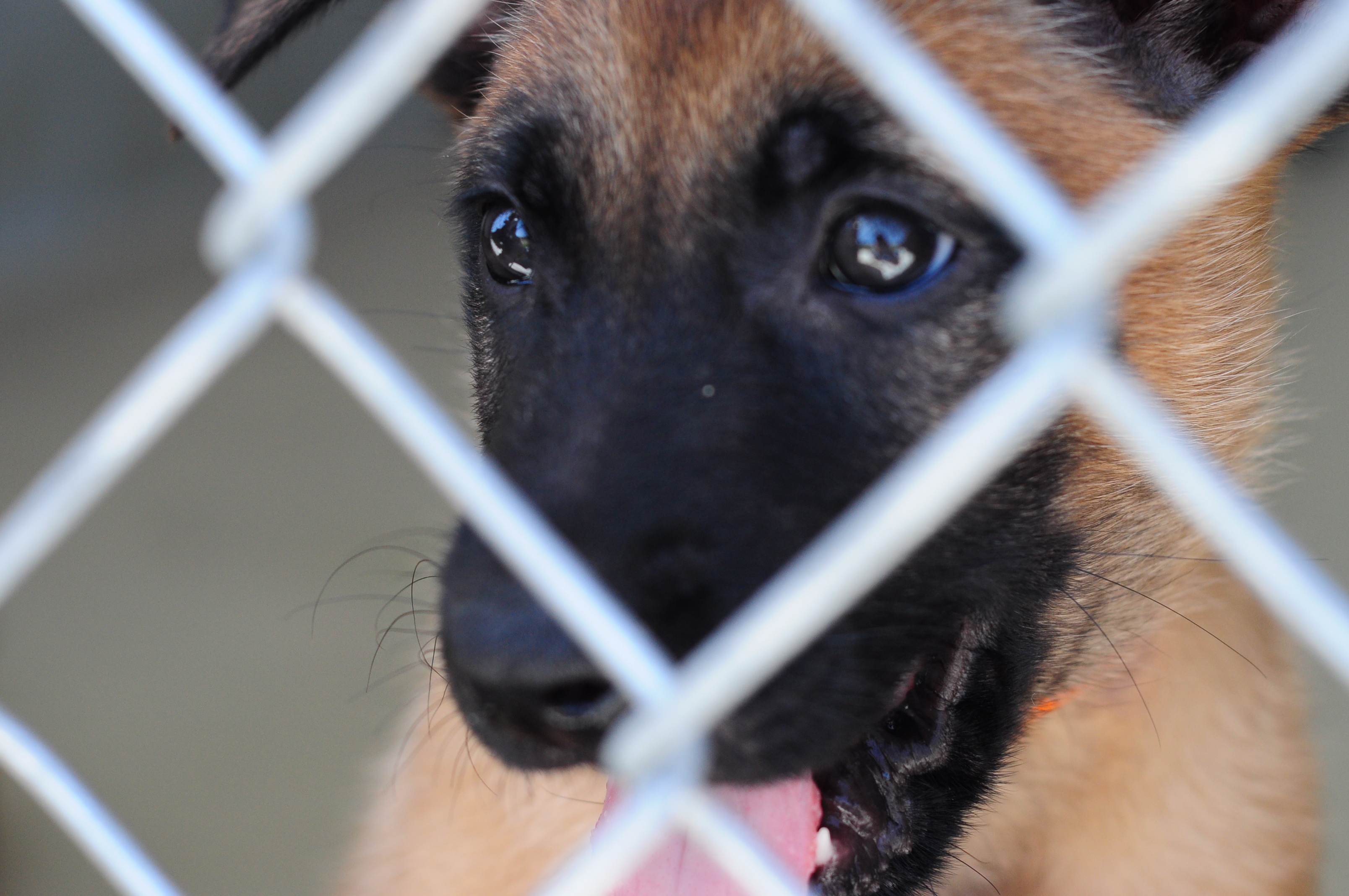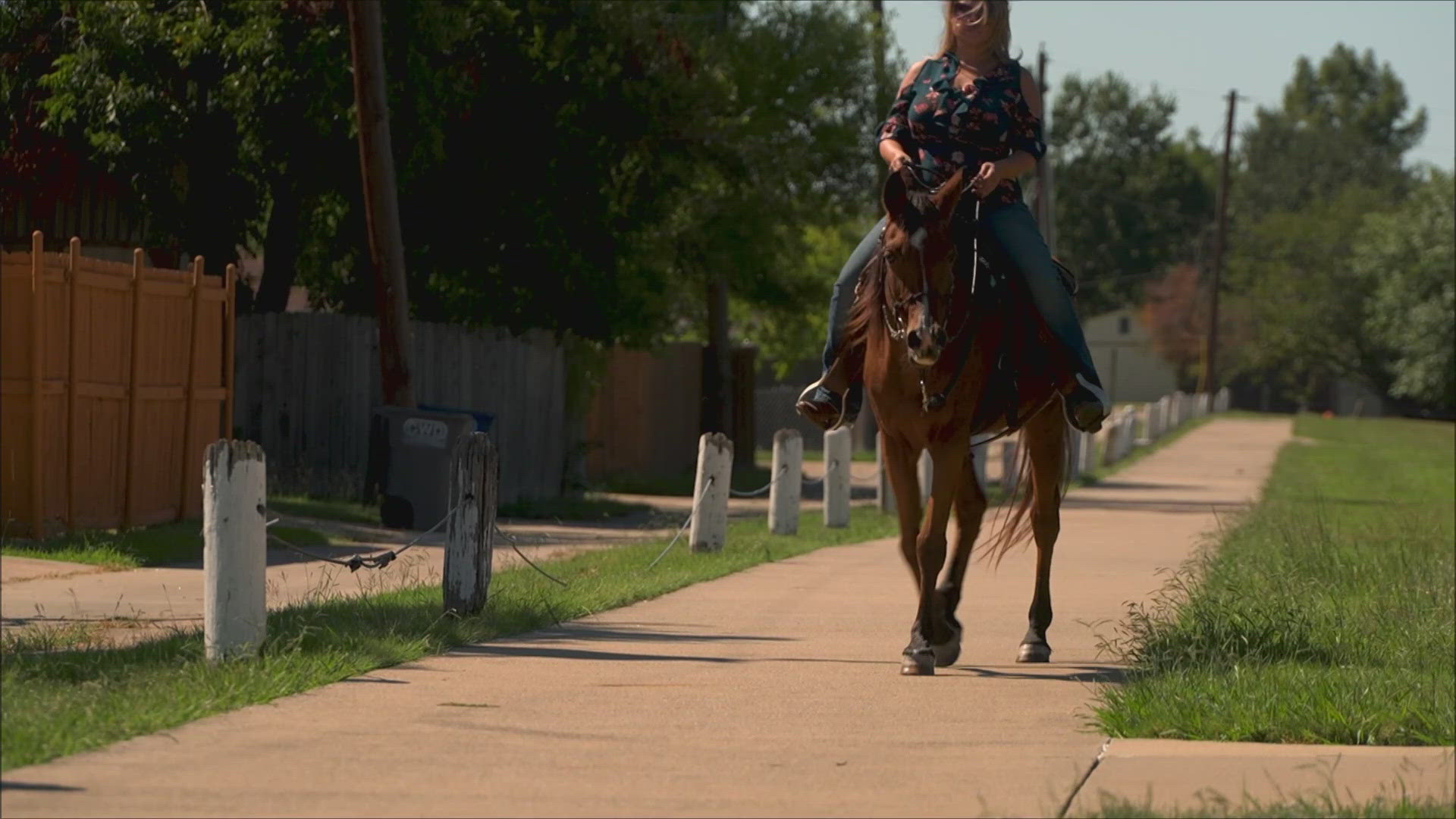SAN ANTONIO -- Polly Miller has to be careful not to leave her closet open. Her new house guest loves chewing on shoes.
This is Aarno, Miller said, the terrorist... hunter.
It's true. Since arriving to her house several weeks ago, the puppy has been terrorizing Miller's shoe closet and her three other dogs. The cats don t like him, either.
He s a normal little kid, Miller said. He runs around, he wants to play. He s exploring. So I call him the terrorist, then I pause... and say hunter.
One day, Aarno may really be hunting down terrorists overseas.
Aarno was born and bred at Lackland Air Force Base. The Department of Defense Military Working Dog program procures hundreds of dogs from overseas each year -- mostly German shepherds.
But not Aarno. He s one of nearly 100 Belgian malinois pups born on base each year. The breeding program started in 1998 and has been growing ever since, with a goal to increase the number of pups born each year to 150 to 200.
WATCHING OUT FOR TROOPS
More puppies essentially means more protection for American troops.
Dogs are the number one means of force protection, said Dr. Stewart Hilliard, who manages the breeding program. There is no single instrument or machine that can protect against explosives, that is as effective a counter-measure against explosives as dogs are. So they re an absolutely critical resource.
Rather than relying largely on foreign countries to provide future military working dogs, Hilliard said the breeding program aims to develop an organic capability for the Department of Defense to produce its own dogs.
More dogs also means finding more volunteers, which is a task of its own.
Miller is a master sergeant in the Air Force. She works right across from the fostering building, so she's seen the puppies and she knows how cute they are.
The puppies are given to foster families in the community at 8 to 9 weeks old and return to the Air Force base at around 7 months old. During that time, the puppies become socialized with humans and basically learn how to, well, be a dog.
But not just any dog.
They re not pets. They re not pets at all, Miller said. They work, and that s what they re bred for.
AN UNCOMMON BREED
Miller has been raising Aarno differently than she has her other dogs. She takes him everywhere -- to work, to restaurants, on elevators and plenty of walks through the neighborhood. He s a service dog, so there aren t many places he can t go.
Miller said she wants him to get used to all different types of sights and sounds.
That s exactly what foster volunteers are asked to do, said David Concepcion-Garcia, one of the foster program coordinators.
We ask that folks introduce new experiences, object and places in a positive manner, he said. When they go out to (military) theater later as adult dogs, they have to be comfortable in their skin to do a job with the background distracters going on.
Baseball games, football games and kids band practices are all great ways to socialize the dogs, explained Jimmy Dalton, another foster program coordinator and former Army dog handler.
Any family activity, we like for it to be a dog activity, too, he said. So it can get used to any type of people, noises, surroundings, environments (and) floor surfaces.
SOME BITING IS ENCOURAGED
It s about confidence. The dog has to be confident, and that includes biting.
Miller has a few more bruises on her forearms than she had when raising her other dogs. Aarno is not a pet; he s a working dog. One day he will have to bite.
It s a delicate process.
We want to discourage them from biting us, of course, Miller said. But we don t want to drive that out, because that s something they re going to have to do.
Malinois are often called maligators because of their alligator-like jaws. But rather than saying no every time he bites, Miller said she tries to redirect Aarno s attention to something else, like his squeaky giraffe toy. And he better love chewing on that toy. His future as a military working dog depends on it.
Aarno will return to Lackland at 7 months old to be tested on three categories: environment stability, his desire to play with toys and his potential to show aggression when threatened.
If he passes the test, Hilliard said he will be quite likely to grow up into a good military Working dog. Only about 40 to 50 percent of the puppies actually make it.
The successful puppies continue onward with pretraining until about 12 months. Then they graduate into formal training, where they learn substance detection and patrol.
If all goes well, after 100 to 120 days, the dogs become dual certified military working dogs. Finally, they go to their field installations to become certified with a particular handler.
At that point, they are ready to go overseas and save lives.
DOGS SAVE THOUSANDS
There are 2,700 military working dogs serving all branches of the military worldwide. Since 2005, 21 dogs have been killed in action.
Hilliard said it s hard to quantify how valuable the dogs are to American troops because it s hard to count the number of soldiers who don t get hurt by a bomb that the dog detected.
However, Gerry Proctor, a spokesman for Lackland Air Force Base, said it has been estimated that a single dog saves about 1,800 American service members.
Miller said she keeps that in mind when working with Aarno.
I ve talked to so many people who have been in Afghanistan and in Iraq and they re like, These dogs save our lives. It s unbelievable because they can detect things so much faster than we can, she said.
She will also keep that in mind when it comes time to give Aarno back to the Air Force base.
That s my rationale for letting him go, she said.
In about four months, Aarno will join the other 900 dogs at Lackland Air Force Base. He will be tested on how much he likes playing with his Kong -- a rubber chew toy -- and how aggressive he gets when someone tries to take it away.
LEGACY OF SERVICE
If he passes, Aarno will be on his way to joining an elite group of dogs that have passed through Lackland Air Force Base. Among those dogs is Nemo, who is perhaps the most legendary of all military working dogs.
Nemo is credited with thwarting an attack on a U.S. Air Base just outside of Saigon in December 1966. He detected several enemy troops hiding in a nearby graveyard.
He and his handler managed to kill two of the enemy commandos, but were both wounded during the attack. Nemo lost his right eye and was shot in the nose. He laid atop his handler, protecting him until reinforcements arrived.
And there is always the chance that Aarno won't make it into the program. In that case, he would be offered back to Miller or to law enforcement agencies.
The dogs that are rejected are not lame dogs, Hilliard said. The program is just very selective. The rejected puppies as well as retired military working dogs make wonderful companions.
These puppies come form a stock of dogs that are basically sound, good temperment kind of dogs, Hilliard said. And if they don t end up with the extraordinary characteristics that make a military working dog, what they wind up being is good pet material, good companion dog material.
And if Aarno doesn t make the cut?
I d probably have to take him back, Miller said. We already have that bond.
Although she loves toting Aarno around with her everywhere she goes, Miller said she hopes he does succeed. Some of the handlers said he s already showing great signs.
But before he becomes as great of a dog as Nemo, he needs to grow one puppy step at a time.
That's fine with Miller, who already has the next question for Aarno:
Are you ready to go to work?
----
Anyone interested in becoming a foster volunteer should call 210-671-3686. The puppies, all materials and food are provided by the foster program at no charge. Formal puppy training classes are offered twice a week, and hotline help is available 24/7. Puppy-sitting services are also available.


